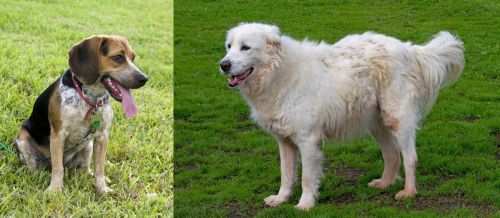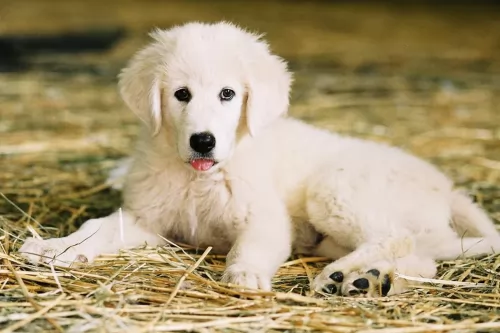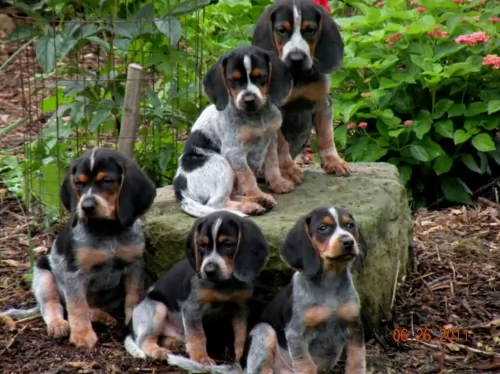 MyDogBreeds
MyDogBreeds Bluetick Beagle is originated from United Kingdom but Abruzzenhund is originated from Italy. Bluetick Beagle may grow 32 cm / 12 inches shorter than Abruzzenhund. Bluetick Beagle may weigh 33 kg / 72 pounds lesser than Abruzzenhund. Both Bluetick Beagle and Abruzzenhund has almost same life span. Bluetick Beagle may have less litter size than Abruzzenhund. Bluetick Beagle requires Low maintenance. But Abruzzenhund requires Moderate maintenance
Bluetick Beagle is originated from United Kingdom but Abruzzenhund is originated from Italy. Bluetick Beagle may grow 32 cm / 12 inches shorter than Abruzzenhund. Bluetick Beagle may weigh 33 kg / 72 pounds lesser than Abruzzenhund. Both Bluetick Beagle and Abruzzenhund has almost same life span. Bluetick Beagle may have less litter size than Abruzzenhund. Bluetick Beagle requires Low maintenance. But Abruzzenhund requires Moderate maintenance
 Among the hound group of dogs, there are some ancient breeds. The history of the Beagle and the Bluetick Beagle more specifically is fairly uncertain as breeds as we know them today didn't really develop until the 19th century. It was in the mid-1800s the Reverend Phillip Honeywood established Beagles in Essex, England and American breeders started importing Beagles from England to improve the looks of their own dogs. The breed was developed from a number of breeds and possibly the Bluetick Coonhound had some input into the markings of the Bluetick Beagle.
Among the hound group of dogs, there are some ancient breeds. The history of the Beagle and the Bluetick Beagle more specifically is fairly uncertain as breeds as we know them today didn't really develop until the 19th century. It was in the mid-1800s the Reverend Phillip Honeywood established Beagles in Essex, England and American breeders started importing Beagles from England to improve the looks of their own dogs. The breed was developed from a number of breeds and possibly the Bluetick Coonhound had some input into the markings of the Bluetick Beagle.
Today the American Kennel Club recognizes many colors and color combinations in Beagles. with white, tan and black being the more common color. Beagles can also sport ‘markings’ such as blue and red freckles or ticks. If there are black ticks, it can be referred to as blue-ticked.
 Abruzzenhund was established as an individual breed in the middle of the 20th century. They are descendant of the big, white Eastern sheepdogs which came to Europe 2000 years ago. Abruzzenhund is a mix of Turkish sheepdogs Akbash and Karabash, the Kuvac, Slovakian breed Hungarian breed, Komondor, and a French sheepdog Pyrenean Mountain Dog. Those dogs were much bigger than today’s breed. Abruzzenhund is still not very popular breed, but it is very common in Great Britain and Italy. They have been used as guard dogs, hunting dogs, and working dogs because they are very brave and strong.
Abruzzenhund was established as an individual breed in the middle of the 20th century. They are descendant of the big, white Eastern sheepdogs which came to Europe 2000 years ago. Abruzzenhund is a mix of Turkish sheepdogs Akbash and Karabash, the Kuvac, Slovakian breed Hungarian breed, Komondor, and a French sheepdog Pyrenean Mountain Dog. Those dogs were much bigger than today’s breed. Abruzzenhund is still not very popular breed, but it is very common in Great Britain and Italy. They have been used as guard dogs, hunting dogs, and working dogs because they are very brave and strong.
 The Bluetick Beagle is a small sized hunting dog. As part of the Hound group of dogs, he has an excellent sense of smell. He has always been used as a hunting dog, and it is why this particular dog is a popular choice for law enforcement agencies – it’s that keen sense of smell.
The Bluetick Beagle is a small sized hunting dog. As part of the Hound group of dogs, he has an excellent sense of smell. He has always been used as a hunting dog, and it is why this particular dog is a popular choice for law enforcement agencies – it’s that keen sense of smell.
He is lean and compact with muscular legs, a broad head, fairly long floppy ears and a broad chest. His coat is short-haired and smooth and its the short blue coloration in his coat sets the Bluetick Beagle apart from the regular Beagle.
The Blue Tick Beagle can have a bit of a stubborn streak, but be that as it may, he still responds well to training and socialization. Alert, he has an amicable nature, and this is what makes this breed such a great family pet He’ll get on well with children in the house as well as with other pets.
The Blue Tick Beagle isn’t an aggressive dog breed. He is lively and playful and full of energy and will require you taking him on walks, runs in the park and lots of games at home.
He loves the companionship of his human family and can’t just be left in the back yard on his own for long periods of time. He can suffer with separation anxiety and also become bored and then he starts with long, mournful howls.
 A height of Abruzzenhund variates between 60-73 cm, males are slightly bigger than females. While the weight is 30-45kg, again, males are heavier than females.
A height of Abruzzenhund variates between 60-73 cm, males are slightly bigger than females. While the weight is 30-45kg, again, males are heavier than females.
Abruzzenhund lifespan is between 11-13 years, but since these dogs don’t have any weaknesses and don’t tend to get sick, they can live longer with a proper care and adequate food and training.
Litter size of Abruzzenhund depends, but as any large breed, they usually have 6-9 puppies. And that is a very good considering size of the breed.
Abruzzenhund is not the only name of this breed. There are more names that you might hear. You can hear names like Maremma, Pastore, Abruzzese, Cane da Pastore, Maremmano- Abruzzese, Italian Sheepdog, and many similar names. Basically, they sound similar but there are differences.
Abruzzenhund is a friendly dog, but it is very powerful. Very strong jaw with a scissors bite makes them very strong. They have small but intelligent eyes, usually dark colored. The undercoat is dense, while the coat is white with segments of ivory to white yellow. Their long undercoat and coat make them winter resistant.
 Your Blue Tick beagle is an active, cheerful dog and he makes a good companion for adult or child. He is fairly adaptable and can happily fit into a home in the city- or country. A Blue Tick Beagle doesn’t want to be left alone day after day, so think about your work commitments before you buy buy your Blue Tick and leave him alone.
Your Blue Tick beagle is an active, cheerful dog and he makes a good companion for adult or child. He is fairly adaptable and can happily fit into a home in the city- or country. A Blue Tick Beagle doesn’t want to be left alone day after day, so think about your work commitments before you buy buy your Blue Tick and leave him alone.
Being a hound, although he is gentle and amicable, he can also be stubborn which means he will require some patient training. Because he is a scenthound, he is inclined to catch an aroma and want to go after it, so you’ll need a well fenced garden to keep him in.
Other than that when he is with you, he makes a dedicated and loving companion.
 Abruzzenhund is a very well-balanced breed who loves spending time with other animals and people. They have a very good temper. They love being around families, and they are very gentle with children. It is important to train Abruzzenhund properly because the dog of that size should be a leader. A human with a strong character should train this breed. Training is important because they tend to make their own decisions which can be bad sometimes.
Abruzzenhund is a very well-balanced breed who loves spending time with other animals and people. They have a very good temper. They love being around families, and they are very gentle with children. It is important to train Abruzzenhund properly because the dog of that size should be a leader. A human with a strong character should train this breed. Training is important because they tend to make their own decisions which can be bad sometimes.
 Beagles are healthy dog breeds, and with good care, can enjoy an average lifespan of between 12-15 years. Like many other dogs, the Blue Tick beagle is more prone to a number of medical conditions, and more so as it ages. It is essentially a hardy breed that won’t require any particular special care, but common dog problems such as hip dysplasia and skin allergies will need to be watched.
Beagles are healthy dog breeds, and with good care, can enjoy an average lifespan of between 12-15 years. Like many other dogs, the Blue Tick beagle is more prone to a number of medical conditions, and more so as it ages. It is essentially a hardy breed that won’t require any particular special care, but common dog problems such as hip dysplasia and skin allergies will need to be watched.
There are always some health concerns with every dog breed that every dog owner needs to be aware of. Dog with floppy ears such as what the Blue Tick Beagle has will always be prone to ear infections. The ears will need to be kept clean but you can’t just go prodding around in a dog’s ear as you could damage the ears. A visit to the veterinarian will clear up any ear problems.
This particular condition - prolapse of the gland of the nictitating membrane – is important to clear up quickly as it could lead to more serious problems. The longer the third eyelid gland is problematic, the more irritated and inflamed it becomes.
 A good, nutritious diet will help your Blue Tick Beagle steer clear of ill health. He is an energetic breed so will require either home prepared food or commercially manufactured dog food with the right mix of vitamins and minerals to keep his energy levels up.
A good, nutritious diet will help your Blue Tick Beagle steer clear of ill health. He is an energetic breed so will require either home prepared food or commercially manufactured dog food with the right mix of vitamins and minerals to keep his energy levels up.
As mentioned, your BlueTick can be prone to hip dysplasia and skin allergies so a supplement which includes omega 3 is an excellent choice for your dog’s overall health. Make sure to include some raw meat into your dog’s diet and always ensure a constant supply of fresh water.
Your Bluetick Beagle isn’t a huge shedder with his short-haired coat, but he will need to be brushed at least twice a week to keep his coat in tip-top condition and to remove all those loose hairs. Bathing a dog is never encouraged as it removes the dogs natural oils, but of course there are always exceptions when a dog will require a bath.
 They learn very quickly, but it requires strong will and constant training to keep them happy. They are great working dogs, and with the positive training, they are amazing. It is very important that they follow rules and to keep them in balance with training.
They learn very quickly, but it requires strong will and constant training to keep them happy. They are great working dogs, and with the positive training, they are amazing. It is very important that they follow rules and to keep them in balance with training.
They can eat a lot of food, depend on their activity. High-Quality dog food twice a day for a grown dog is a must. While puppies should eat 3-5 times, smaller portions of food. The food is important especially for working dogs, they need up to 2000-3000Kcal per day. Abruzzenhund will enjoy eating meat with a lot of vegetables and oil.
They are not recommended for small house or apartment. They need big yard because they require a lot of space. During the winter they can be outside because of their coat, but during the summer they need to be in the shade with a lot of fresh water available anytime.
The coat should be brushed and groomed very often because they have a thick coat. There is a lot of dead and loose hair in it. During shedding, period takes even more time to groom your dog properly. They love and they need exercise. Mental exercise is important as physical. Every day walking, running, playing with other animals is an important part of dog's activity. When they get enough quality exercise, they will sleep in the house.